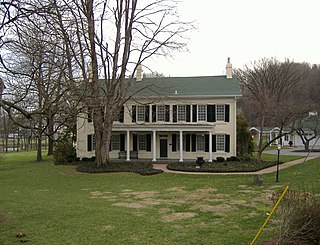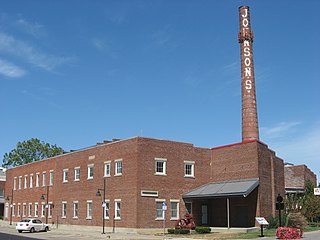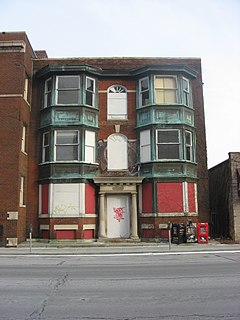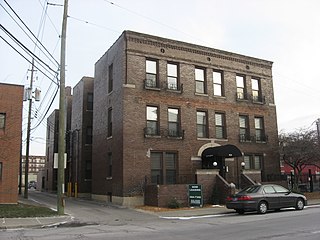
Fletcher Place is a historic district and neighborhood in the city of Indianapolis, Indiana named after Calvin Fletcher, a prominent local banker, farmer and state senator.

The Kintner-McGrain House, also known as Cedar Glade, is on the National Register of Historic Places, located north of downtown Corydon, Indiana. It attained the "Cedar Glade" name due to the giant red cedars Jacob Kinter, the builder, planted in front of the house. It has been owned by three different families: Kintners (1808), McGrains(1849), and Bennetts (1998). It is the second-oldest building in Harrison County, Indiana. It was built in 1808, and is a Late Federal/Early Republic Style, "L"-shaped, brick dwelling. During John Hunt Morgan's raid in 1863, noncombatants took refuge in the house. Ironically, several cannonballs landed in the front yard. Until 1946 it was a working farm.

Forest Hills Historic District is a national historic district located at Indianapolis, Indiana. It encompasses 173 contributing buildings and 7 contributing structures in a planned residential section of Indianapolis. It developed between about 1911 and 1935, and includes representative examples of Tudor Revival and English Cottage style architecture.

Amo THI & E Interurban Depot/Substation, also known as Amo Interurban Depot, is a historic interurban train station located at Amo, Hendricks County, Indiana. It was built in 1907 by the Terre Haute, Indianapolis and Eastern Traction Company. The building consists of a small brick passenger/cargo depot with a large, two-story repair substation at the rear. It has Romanesque Revival and Queen Anne style design elements. The passenger depot section is topped by a series of red clay tile hipped roofs. Interurban transportation for Amo ceased on January 10, 1940. The building was renovated in the 2000s for use as a library and community center.

THI and E Interurban Depot-Substation, also known as Plainfield Interurban Depot, is a historic interurban train station located at Plainfield, Hendricks County, Indiana. It was built in 1907 by the Terre Haute, Indianapolis and Eastern Traction Company. The building consisted of a small brick passenger / cargo depot in the front facing the street and track plus a large, two-story repair facility and power conversion AC to DC substation at the rear. Holes in the upper part of the substation walls are where electrical transmission wires entered and left. It has Italianate style design elements in the round arched window openings. The passenger depot section is topped by a series of red clay tile hipped roofs. Interurban transportation for Plainfield ceased on January 10, 1940. The building was subsequently used as an American Legion post.

Coca-Cola Bottling Company Plant is a historic Coca-Cola bottling plant located at Bloomington, Monroe County, Indiana. The original section was built in 1924, and is a two-story, roughly square, red brick building. A one-story section was added in a renovation of 1938–1939, along with Art Deco style design elements on the original building. It closed as a bottling plant in 1989, and subsequently converted for commercial uses.

Home Laundry Company is a historic laundry building located at Bloomington, Monroe County, Indiana. The original section was built in 1922, and is a two-story, roughly square, red brick building. A one-story Moderne style wraparound addition was built in 1947–1948. It continued to house a laundry when listed in 2000 and currently houses a Chinese restaurant..

Johnson's Creamery is a historic creamery building located at Bloomington, Monroe County, Indiana. The original section was built about 1914, and is a two-story, rectangular, red brick building. Additions were made to the original building until 1951, and are all constructed of red brick with parapets. The iconic smokestack dates to 1949. Johnson's Creamery vacated the building in 1987.

The Alexandra, also known as Lockerbie Court, is a historic apartment building located at Indianapolis, Indiana. It was built in 1902, and is a three-story, red brick and grey limestone building on a raised basement with Georgian Revival style detailing. It features six three-story polygonal bay windows on the front facade.

The Lodge is a historic apartment building located at Indianapolis, Indiana. It was built in 1905, and is a three-story, three bay, rectangular, Georgian Revival style red brick building. It features a limestone entrance portico with Ionic order columns and three-story bay windows.

The Pennsylvania is a historic apartment building located at Indianapolis, Indiana. It was built in 1906, and is a three-story, double "H" plan, Classical Revival style red brick and grey limestone building. It features a round arched main entrance, wrought iron balcony grills, and terra cotta coping.

The Grover is a historic apartment building located at Indianapolis, Indiana. It was built in 1914, and is a three-story, "I"-shaped, red brick building. It features a recessed entrance with limestone voussoir arch, bay windows on the upper stories, and a limestone frieze.

Delaware Court is a historic apartment building located at Indianapolis, Indiana. It was built in 1917, and is a two-story, "E"-shaped, Tudor Revival style red brick and grey limestone building on a raised basement. It features a flattened Tudor arched entrance, stepped gables and limestone plaques with heraldic escutcheons.

The Burton is a historic apartment building located at Indianapolis, Indiana. It was built in 1920, and is a two-story, Spanish Colonial Revival style stuccoed building on a raised basement. It features a semicircular metal arched entrance hood, stepped gables, and a red tile roof.

The Spink, also known as the Jefferson, is a historic apartment building located at Indianapolis, Indiana. It was built in 1922, and is a six-story, "I"-shaped, Tudor Revival style red brick building on a raised basement. It features full six-story projecting bays and two bay units starting on the third floor.

The Chadwick was a historic apartment building located at Indianapolis, Indiana. It was built in 1925, and was a three-story, five bay, "I"-shaped, Georgian Revival style buff brick building with limestone detailing. It featured Tuscan order engaged columns at the entrance. It was destroyed by fire in January 2011.

The Blacherne is a historic apartment building located at Indianapolis, Indiana. It was built in 1895, and is a large seven-story, 6 bay by 15 bay, red pressed brick building on a limestone foundation. It features two circular projecting bays at the corners and a semicircular limestone Romanesque Revival style entry portal.

The Sid-Mar is a historic apartment building located at Indianapolis, Indiana. It was built in 1887, and is a three-story, triangular, Italianate style red brick building. It has commercial storefronts on the first floor and segmental arched and projecting bay windows on the upper floors.

Independent Turnverein, also known as the Hoosier Athletic Club and Marott Building, is a historic clubhouse located at Indianapolis, Indiana. It was built in 1913–1914, and consists of a main three-story brick pavilion connected by a two-story section to a second three-story brick pavilion. It has Prairie School and American Craftsman design elements, including a red tile hipped roof. It features paneled and decorated pilasters, a second floor Palladian window, and limestone decorative elements. The building was remodeled in 1946.

Gaseteria, Inc., also known as ACLU, Indiana, historic apartment building located at Indianapolis, Indiana. It was built in 1941, and is a one-story, Art Moderne style, buff-color and red brick building with limestone detailing and a flat roof. It features curved walls and glass-block windows. It was built to house the offices of the Gaseteria filling station company.
























